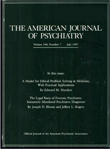The dexamethasone suppression test in panic disorder and agoraphobia
Abstract
Reports that imipramine and phenelzine prevent panic attacks in agoraphobia suggest the possibility that agoraphobia and/or panic disorder might be a clinical manifestation of underlying depression. To test this hypothesis, dexamethasone suppression tests (DSTs) were performed in 10 patients meeting DSM-III criteria for agoraphobia with panic attacks, 6 for panic disorder, and 4 whose diagnosis could have been either panic disorder or agoraphobia except that another axis I disorder precluded such a diagnosis. Abnormal DSTs were observed in only 3 patients and appeared to be attributable to causes other than panic attacks or agoraphobia. The results suggest that panic attacks and endogenous depression are separate disorders and that the antipanic properties of imipramine and phenelzine are separate from their antidepressant actions.
Access content
To read the fulltext, please use one of the options below to sign in or purchase access.- Personal login
- Institutional Login
- Sign in via OpenAthens
- Register for access
-
Please login/register if you wish to pair your device and check access availability.
Not a subscriber?
PsychiatryOnline subscription options offer access to the DSM-5 library, books, journals, CME, and patient resources. This all-in-one virtual library provides psychiatrists and mental health professionals with key resources for diagnosis, treatment, research, and professional development.
Need more help? PsychiatryOnline Customer Service may be reached by emailing [email protected] or by calling 800-368-5777 (in the U.S.) or 703-907-7322 (outside the U.S.).



